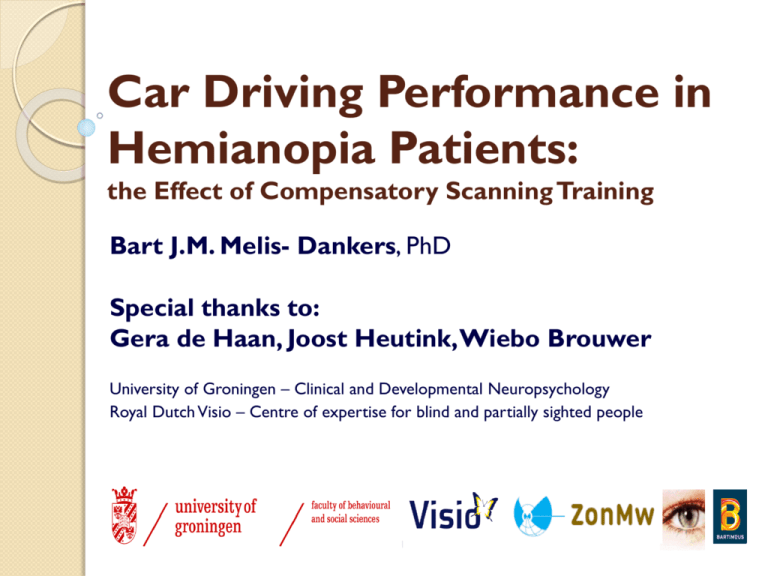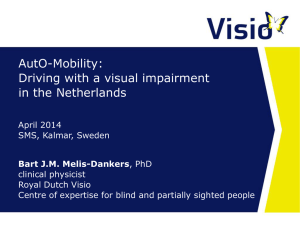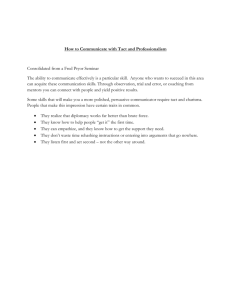Inzicht Hemianopsie
advertisement

Car Driving Performance in Hemianopia Patients: the Effect of Compensatory Scanning Training Bart J.M. Melis- Dankers, PhD Special thanks to: Gera de Haan, Joost Heutink, Wiebo Brouwer University of Groningen – Clinical and Developmental Neuropsychology Royal Dutch Visio – Centre of expertise for blind and partially sighted people Regulations - NL Ministry of Transport, 2009/2010: Horizontal Visual Field (HVF): HVF > 120° : unrestricted driving license -- at least 50° right/left, + 20° up/down -- no binocular scotoma in central 20° field HVF < 90° : not fit to drive 90°< HVF<120° : driving test possible Hemianopia - safe drivers Tant (2002) Brouwer (2013) Racette&Casson (2005) Owsley-group (2009/2011) In general: ◦ ◦ ◦ ◦ ◦ ◦ - 4/28 (14%) 7/17 (42%) 8/20 (40%) 23/30 (77%) steering instability and unsuitable positioning on the road difficulties with gap judgment driving too slow or too fast too much sudden braking inconsequent viewing behavior poor reaction to unexpected events Participants in driving study N = 26 adults reporting mobility problems because of a homonymous hemianopia M(TimeSinceLesion) = 14.8 months [6 - 41] N = 21 left-sided, N = 5 right-sided hemianopia N = 18 male, N = 8 female M(age) = 52 [27-71, SD = 11.7] M(DrivingExperience) = 29 years [3 – 53] No severe motor, (neuro)psychologic or hearing disorders No ophthalmologic dysfunctioning; Binocular visual acuity ≥ 0.5 5 Design Training group T1 Training T2 pre post Control group T1 T2 Training T3 -3mth Tests on T1, T2 and T3: Impaired Mobility Questionnaire (IMQ; Turano, 1999) Obstacle course (with dual task) Tracking Task Hazard perception (Vlakveld, 2011) ---------------------------------------------------------------------------- Driving simulator Practical fitness to drive [CBR] 6 Obstacle course (dual task) Walking time (sec) 90 80 70 60 50 40 30 20 10 0 pre post Result no dual task dual task free course no dual task dual task obstacle course Tracking task RT (ms) on blind and seeing side 1600 1540 1306 990 1200 866 800 pre post 400 0 blind Result seeing Total omissions on blind and seeing side 7 8 6 pre 4 1 post 2 0 0 0 blind seeing Hazard perception Vlakveld-test With eye movement recording Keep on going? Foot off gas pedal? Break? Keep on going? Foot off gas pedal? Break? Keep on going? Foot off gas pedal? Break? Driving simulator slightly winding road slightly winding road slightly winding road rural, 2-lane road + crossings rural, 2-lane road + crossings fixed speed (50 km/h) free speed instruction: in a hurry fixed speed free speed 15 Practical Fitness to drive: TRIP Test Ride for Investigating Practical fitness to drive 57 items: insufficient, doubtful, sufficient Driving test taken by ‘blind’ CBR-expert Factors: ◦ VIS: visual factor ◦ OPER: operational factor ◦ TACT: tactical factor Scores: ◦ 1 = insufficient ◦ 2 = doubtful ◦ 3 = sufficient / good 16 Fitness to drive N = 26 Hemianopia patients (total N = 57) N = 21 left-sided, N = 5 right-sided hemianopia N = 18 male, N = 8 female M(Age) = 52 [27-71] CBR (Dutch department of motor vehicles) 2 on-road driving assessments: 12 failed (46%) Before onset of training (N=26) 14 passed (54%) 17 Fitness to drive: total group VIS ◦ Insufficient 15% ◦ Doubtful 13% ◦ Sufficient 72% OPER ◦ Insufficient 10% ◦ Doubtful 11% ◦ Sufficient 79% TACT ◦ Insufficient 11% ◦ Doubtful 13% ◦ Sufficient 76% Reasons for negative judgement VIS Total (N=26) Fit to drive (N=14) Unfit to drive (N=12) p-valuea 2.59 (0.52) 2.92 (0.10) 2.20 (0.53) <.001** OPER TACT GLOB 2.71 (0.48) 2.97 (0.07) 2.40 (0.58) <.001** 2.66 (0.42) 2.92 (0.10) 2.36 (0.44) <.001** 2.50 (0.65) 3.00 (0.00) 1.92 (0.52) <.001** 19 Patient characteristics No effect on TRIP subscales: ◦ Age, Gender, and Years of driving experience ◦ Time since onset, but: longer time since onset > lower VIS (p=.072) Time not driven (M=15 months, 0-72): ◦ Trend for difference between the “fit” and “unfit” drivers (p=.060) ◦ The more time the patient had not driven, the lower the scores on VIS (p=.014) and OPER (p=.010) ◦ No significant correlation for TACT (p=.159) Compensatory Scanning Training Royal Dutch Visio: 18 hours of training Aimed at improving “slow mobility” 1. Increase insight 2. Systematic scanning strategy 3. Transfer to mobility in daily life Fitness to drive N = 26 Hemianopia patients (total N = 57) N = 21 left-sided, N = 5 right-sided hemianopia N = 18 male, N = 8 female M(Age) = 52 [27-71] CBR (Dutch department of motor vehicles) 2 on-road driving assessments: 12 failed (46%) Before onset of training (N=26) 14 passed (54%) 5 failed After training (N=9) 4 passed 22 Fitness to drive: TRIP TRIP-factors improve after training (N = 9) 3 2.5 Drive1 Drive2 2 1.5 1 VIS OPER TACT GLOB TOT 23 Driving simulator 24 Effect of training: VIS Conclusion Self-reported mobility in daily life improved (IMQ) Faster responses to stimuli in the blind periphery (Tracking Task) Higher walking speed in obstacle course with cognitive dual task Part of patients with hemianopiae is practical fit to drive, even without training. Visual aspects of driving are most problematic. Negative judgement due to insufficient viewing strategy, but also due to operational and tactical driving. Training improves visual and tactical aspects. No age-related effect found. -------------------------------------------------------------------------------------Hemianopia does not necessarily impair fitness to drive 27 University of Groningen Gera de Haan Royal Dutch Visio, Bartiméus Joost Heutink CBR Wiebo Brouwer ZonMw – InZicht Oliver Tucha Thank you for your attention Contact: BartMelis@visio.org







